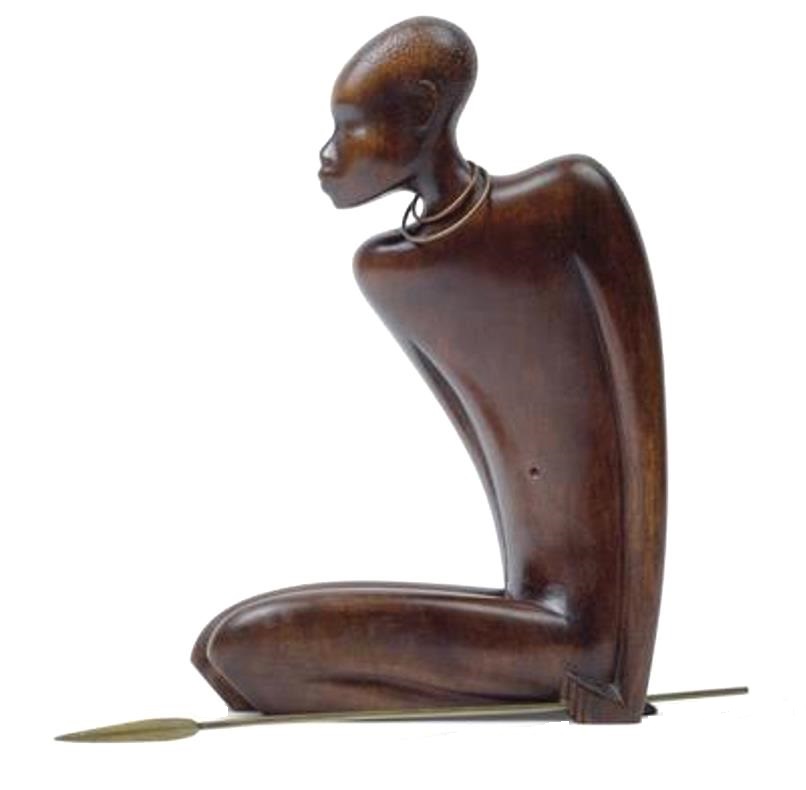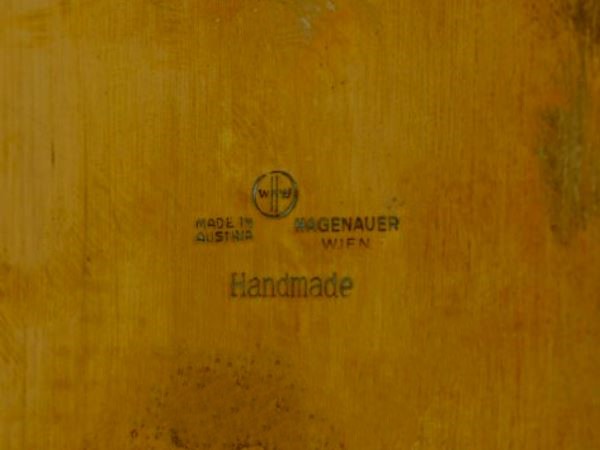Wooden sculpture created by Werkstätten Hagenauer, Vienna circa 1960
A tribal warrior with a spear kneeling created by Werkstätten Hagenauer, Vienna circa 1960
Sculpture of a kneeling figure in carved wood with in his hand brass spear as well wearing 2 necklaces in brass. Piece is signed with impressed workshop signet. wHw, Wien – Handmade – made in Austria.
Dimensions: height: 27 cm x 33 cm – 10.7 x 12.9 in.
Artwork is not available anymore! Sold – Thank you.
Clic here to see more Sculptures or Assemblages>>
Cliquez ici pour voir plus de DESIGN >>
Werkstätten Hagenauer:
The Werkstätte Hagenauer Wien, often abbreviated to wHw, was a family business based in Vienna that produced art and everyday objects for almost 90 years. The workshop closed in 1987, but the company’s retail store, opened in 1938 on Vienna’s Opernring, survives today as a museum and shop.
The company was founded by Carl Hagenauer in 1898. He started as an apprentice at Würbel & Czokally, a silverware producer in Vienna. He then trained as a goldsmith before founding his own business, one of several in Vienna producing small figurines and useful objects. His studio produced his own designs and those of other artists such as Josef Hoffmann and Otto Prutscher.
His sons Karl (1898 – 1956) and Franz (1906 – 1986) both became renowned designers. Karl Hagenauer was an influential designer in the Art Deco style. He enrolled at the Vienna School of Applied Arts at the age of eleven. He studied with Josef Hoffmann and Oskar Strnad and created designs for the Wiener Werkstätte art collective. After serving in the infantry during the war, he resumed his training and qualified as an architect. He joined the family business in 1919 and quickly took charge of both design and management.
Karl Hagenauer responded to the change in public taste influenced by the popularity of the Vienna Secession. His stylized animals and fanciful creatures (reminiscent of Wiener Werkstätte designer Dagobert Peche), handcrafted in brass, had wide appeal in domestic and American markets.
Some were useful, such as mirrors, cigar cutters, ashtrays, cigarette snuffers – many in the shape of athletes or animals, candle holders, corkscrews, bookends and bases of lamps.
Figurines, hood ornaments, and other larger sculptures in wood and metal (such as the iconic Josephine Baker from the collection of the Casa Lis art nouveau and art deco museum in Salamanca) were purely decorative.
He designed the company’s trademark, a circled “wHw”, and registered it in 1927. The first catalog to use the trademark was in 19281, the year his father died and Karl’s assumption of the management of the company. The company later expanded its production to include furniture, primarily designed by Julius Jirasek.
Karl Hagenauer’s designs were popular enough to be reproduced and marketed by counterfeiters in the 1930s and more recently.
Karl Hagenauer’s work found an eager American market in part through the efforts of Rena Rosenthal, a gallery owner in New York, who displayed Josephine Baker’s sculpture in a window display in 1935.
He made two trips to New York to visit her in the 1930s and stamped some of the merchandise sold by her store with a custom “RENA” mark in addition to her trademark “wHw”. Rosenthal’s patronage was crucial to the postwar success of Werkstätte Hagenauer.
#biography and references : Wikipedia and Karl Hagenauer web site
Date:
October 20, 2024

